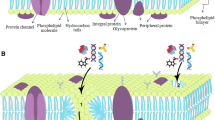Summary
Electroporation was used to introduce plasma membrane impermeable molecules into the cytoplasm of pollen grains ofLilium longiflorum. Ungerminated pollen grains were exposed to the fluorescent dye quin2 or FITC-labelled dextrans and electroporated with exponentially decaying voltage pulses of 250 to 2000 V/cm and time constants of 0.01 to 10 μs. The number of electroporated pollen grains increased with the strength and duration of the voltage pulses, and with the osmolarity of the external medium. Optimal results were obtained with pulses of 1000 V/cm and 10 μs time constant, and with 900 mM mannitol in the electroporation buffer. The size of the pores produced in the plasma membrane by electroporation allowed uptake of 40 kDa dextran but not 70 kDa dextran. The rate of germination of pollen grains was low immediately after electroporation, but increased with time in pollen growth medium. The conditions of electroporation reported here may be used to load genetic material into pollen grains for the production of transgenic plants.
Similar content being viewed by others
Abbreviations
- PGM:
-
pollen growth medium
- FDA:
-
fluorescein diacetate
- FITC:
-
fluorescein isothiocyanate
References
Abdul-Baki AA, Saunders JA, Matthews BF, Pittarelli GW (1990) DNA uptake by electroporation of germinating pollen grains. Plant Sci 70: 181–190
Auer D, Brandner G, Bodemer W (1976) Dielectric breakdown of the red blood cell membrane and uptake of SV40 DNA and mammalian cell RNA. Naturwissenschaften 63: 391
Bates GW, Saunders JA, Sowers AE (1987) Electrofusion: principles and applications. In: Sowers AE (ed) Cell fusion. Plenum, New York, pp 367–395
Chang DC, Chassey BM, Saunders JA, Sowers AE (eds) (1992) Guide to electroporation and electrofusion. Academic Press, San Diego
Cutler AJ, Saleem M (1987) Permeabilizing soybean protoplasts to macromolecules using electroporation and hypotonic shock. Plant Physiol 83: 24–28
Damm B, Schmidt R, Willmitzer L (1989) Efficient transformation ofArabidopsis thaliana using direct gene transfer to protoplasts. Mol Gen Genet 217: 6–12
DeBoer AH, Van Duijn B, Giesberg P, Wegner L, Obermeyer G, Köhler K, Linz KW (1994) Laser microsurgery: a versatile tool in plant (electro)physiology. Protoplasma 178: 1–10
Dekeyser RA, Claes B, DeRycke RMU, Habers ME, Van Montagu MC, Caplan AB (1990) Transient gehe expression in intact and organized rice tissue. Plant Cell 2: 591–602
Fromm M, Taylor LP, Walbot V (1985) Expression of genes transferred into monocot and dicot plant cells by electroporation. Proc Natl Acad Sci USA 82: 5824–5828
Gilroy S, Hughes WA, Trewavas AJ (1986) The measurement of intracellular calcium levels in protoplasts from higher plants. FEBS Lett 199: 217–221
Horsch RB, Fry JE, Hoffman NL, Eichholtz D, Rogers SG, Fraley RT (1985) A simple and general method for transferring genes in plants. Science 277: 1229–1231
Klein TM, Wolf ED, Wu R, Sanford JC (1988) High-velocity microprojectiles for delivering nucleic acid into living cells. Nature 327: 70–73
Liang H, Purucker WJ, Stenger DA, Kubiniec RT, Hiu SW (1988) Uptake of fluorescence-labelled dextrans by 10T1/2 fibroblasts following permeation by rectangular and exponential-decay electric field pulses. BioTechniques 6: 550–558
Lindsay K, Jones MGK (1987) The permeability of electroporated cells and protoplasts of sugar beet. Planta 172: 346–355
Matthews BF, Abdul-Baki AA, Saunders JA (1990) Expression of a foreign gene in electroporated pollen grains of tobacco. Sex Plant Reprod 3: 147–151
Morikawa H, Iida A, Matsuri C, Ikegami M, Yamada Y (1986) Gene transfer into intact plant cells by electroinjection through cell walls and membranes. Gene 41: 121–124
—, Nishihara M, Seki M, Irifune K (1994) Bombardment-mediated transformation of plant cells. J Plant Res 107: 117–123
Neumann E, Sowers AE, Jordan CA (eds) (1989) Electroporation and electrofusion in cell biology. Plenum, New York
Obermeyer G, Weisenseel MH (1991) Calcium channel blocker and calmodulin antagonists affect the gradient of free calcium ions in lily pollen tubes. Eur J Cell Biol 56: 319–327
Ochatt SJ, Chand PK, Rech EL, Davey MR, Power JB (1988) Electroporation- mediated improvement of plant regeneration from colt cherry protoplasts. Plant Sci 54: 165–169
O'Driscoll D, Harm C, Read SM, Steer MW (1993) Endocytotic uptake of fluorescent dextrans by pollen tubes grown in vitro. Protoplasma 175: 126–130
Okada K, Nagata I, Takebe I (1986) Introduction of functional RNA into plant protoplasts by electroporation. Plant Cell Physiol 27: 619–626
Saunders JA, Matthews BF, Van Wert SL (1992) Pollen electrotransformation for gene transfer in plants. In: Chang DG, Chassey BM, Saunders JA, Sowers AE (eds) Guide to electroporation and electrofusion. Academic Press, San Diego, pp 343–354
Scheuerlein R, Schmidt K, Poenie M, Roux SJ (1991) Determination of [Ca2+]i inDryopteris by fura2. Planta 184: 166–174
Stöger E, Benito Moreno RM, Ylstra B, Vicente O, Heberle-Bors E (1992) Comparison of different techniques for gene transfer into mature and immature tobacco pollen. Transgen Res 1: 71–78
Twell D, Klein TM, Fromm ME, McCormick S (1989) Transient expression of chimeric genes delivered into pollen by microprojectile bombardment. Plant Physiol 91: 1270–1274
Wang Y-C, Klein TM, Fromm M, Cao J, Sanford JC, Wu R (1988) Transient expression of foreign genes in rice, wheat and soybean cells following particle bombardment. Plant Mol Biol 11: 433–439
Weaver JC, Powell KT (1989) Theory of electroporation. In: Neuman E, Sowers AE, Jordan CA (eds) Electroporation and electrofusion in cell biology. Plenum, New York, pp 111–126
Zimmermann U (1986) Electric breakdown, electropermeabilization and electrofusion. Rev Physiol Biochem Pharmacol 105: 176–256
—, Pilwat G, Riemann F (1974) Reversable dielectric breakdown of cell membranes by electrostatic fields. Z Naturforsch 29c: 304–305
Author information
Authors and Affiliations
Rights and permissions
About this article
Cite this article
Obermeyer, G., Weisenseel, M.H. Introduction of impermeable molecules into pollen grains by electroporation. Protoplasma 187, 132–137 (1995). https://doi.org/10.1007/BF01280241
Received:
Accepted:
Issue Date:
DOI: https://doi.org/10.1007/BF01280241




